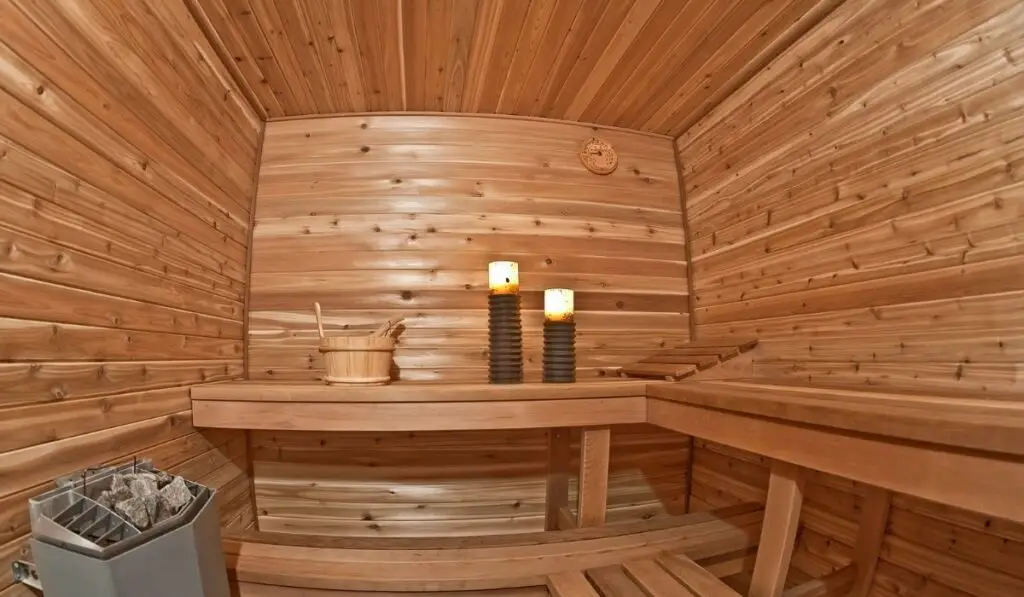Owning a sauna comes with plenty of installation and operation questions. One that often comes up is whether or not you should add ventilation. While saunas may seem like airtight sweat boxes, you might be surprised at how they utilize ventilation.
Saunas do need proper ventilation in order to function properly. They typically have ventilation built-in at the heater where new air is pulled in. You won’t usually need to add another vent, although, having at least one is crucial because proper airflow is fundamental for the sauna.
Ventilation plays a part in almost any sauna system. There are a few reasons why manufacturers place vents in specific locations. Not only do they help with airflow, but they can also help with the operation of the heater. To learn more about saunas and how they use ventilation, read on!
Where Most Saunas Have Ventilation Built-In
Regardless of sauna or wood type (our guide), you will definitely find some ventilation in a few key places. These locations serve different purposes for the operation of the sauna. They’re typically either behind the heater or on the wall.
The vent behind the heater is an essential component to keep the device working correctly. This vent helps bring in fresh air for the heater to use. This helps provide the air for the sauna and helps regulate the temperature of the heater’s motor the same way the sauna hygrometer (on Amazon) does for the general temperature of the room.
The motor could be placed under extra stress without a vent here, reducing the device’s lifespan. Additionally, saunas using traditional sources of heat need the vent to provide fresh oxygen for the fire. Without this vent, then the fire would die.
There will also most likely be a vent to act as a chimney in these cases as well. Another place you might find a vent is on the wall. Sometimes, especially in bigger saunas, you may even find several of them. These vents help regulate the airflow in the cabin and can be open or closed. When they are open, they can reduce the temperature of the sauna quickly. When closed, they can help trap heat inside.
Why Extra Ventilation Isn’t Required in a Sauna

Saunas work by trapping in the heat produced by the heater. This heat is then transferred to your body, causing you to sweat. The walls of the sauna have insulation for this reason. So when you think about ventilation, it doesn’t seem to help in this goal.
If anything, more ventilation will help cool a sauna. This is the case for most sauna ventilation. Usually, you will see vents placed on walls that can be covered to regulate temperature. But if you leave it open for too long, you could be making your heater work overtime to keep the temperature up.
It may be tempting to add more ventilation to your sauna, but this would be inadvisable. Most manufacturers build their saunas to trap as much air as possible. Extra vents could cause this design to perform under par.
All you really need is your two vents, One at the bottom to bring in cool air and one at the top for heat to escape. These not only serve to help bring in the fresh air but also for safety. Another thing that’s worth mentioning is that vents can actually make the sauna appear much hotter – more on that now.
How Vents Can Make a Sauna Feel Hotter
While it might seem counterintuitive, vents can help bring up the heat in a sauna. This is because vents cause the air in the sauna to start moving. You might associate this with something like windchill. But when dealing with hot air, it means moving that air across your body.
If you remember your basic physics, hot air rises. If you place your heater on the floor, a small amount of airflow is all you need to push that air up. Creating a continuous flow of this air is important to keep things fresh and hot.
If you take a look at traditional rather than infrared saunas in Europe (our tutorial), you’ll see a huge gap at the base of the door. This little trick utilizes the same fundamentals as the vents in your at-home sauna. When properly used, this can even help make the sauna hotter.
Venting an Indoor Sauna (Inside or Out?)
If you’ve got an indoor sauna, you should take some extra precautions when thinking about ventilation. For one, you need to remember that fresh air is an essential part of the function of any sauna. Second, you want to make sure that you are being aware of where all the vents are feeding.
If they don’t have them installed properly, there could be some issues. One great thing about an indoor sauna is that you don’t necessarily need to vent to the outdoors. You also don’t need to worry too much about whether or not the air coming in is humid.
Additionally, it should be getting cleaned pretty often anyway and the same thing can be said for sauna blankets like this one (on Amazon) as well. Typically, you don’t need any ductwork for the vents. As long as there’s a clear enough space for them to pull in, the air should be fine.
Wrapping Up
Saunas need ventilation, but maybe not for the reason you think. Saunas use ventilation to help regulate airflow and keep fresh air in the cabin. Without them, not only could your equipment run improperly, but things may not be as comfortable.
